By Leen Randell
Updated: Jul 19, 2024
10 Best Herbal Creams For Frozen Shoulder
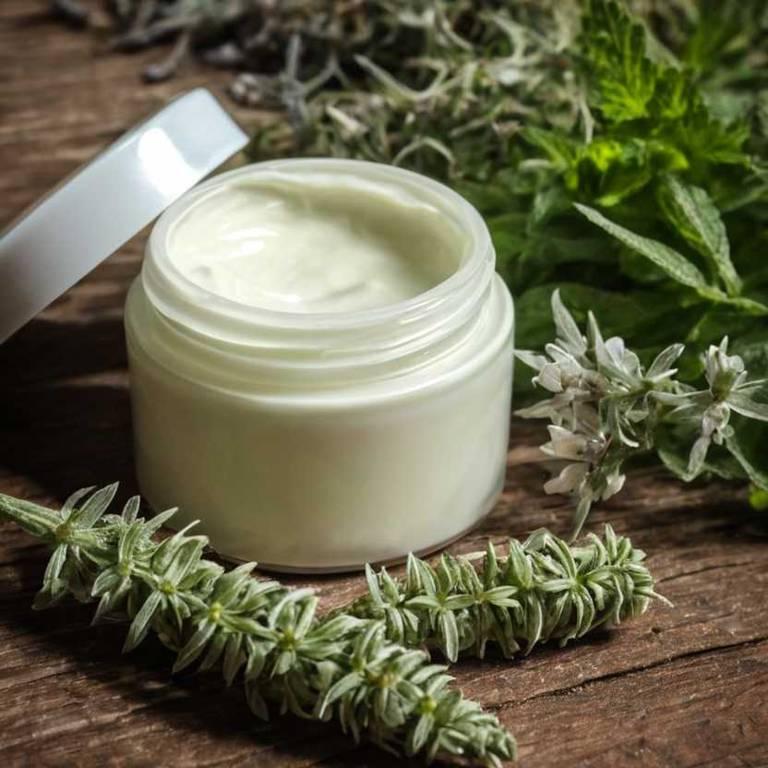
Herbal creams for frozen shoulder are topical ointments infused with natural herbs and essential oils that help alleviate the symptoms of frozen shoulder, a condition characterized by reduced mobility and stiffness in the shoulder joint.
These creams, such as arnica and capsaicin, work by reducing inflammation and promoting relaxation, making it easier to move the shoulder.
By using these creams, individuals can experience improved range of motion and reduced pain, allowing them to resume daily activities and enjoy a better quality of life.
The following article describes in detail the most important creams for frozen shoulder, including medicinal properties, parts of herbs to use, and recipes for preparations.
- 1. Camellia sinensis
- 2. Capsicum annuum
- 3. Glycyrrhiza glabra
- 4. Salix alba
- 5. Echinacea purpurea
- 6. Arnica montana
- 7. Stevia rebaudiana
- 8. Curcuma longa
- 9. Symphytum officinale
- 10. Artemisia absinthium
- What is the best combination of herbal creams to use for frozen shoulder?
- What ailments similar to frozen shoulder are treated with herbal creams?
1. Camellia sinensis
Camellia sinensis, also known as tea, creams helps with frozen shoulder because of its anti-inflammatory and antioxidant properties.
The Camellia sinensis extract, rich in catechins and theaflavins, helps to reduce inflammation and pain associated with frozen shoulder. It also promotes blood flow and relaxation of the muscles, allowing for improved mobility and flexibility.
Regular application of the cream may also help to break down adhesions and scar tissue, contributing to a faster recovery and reduced symptoms of frozen shoulder.
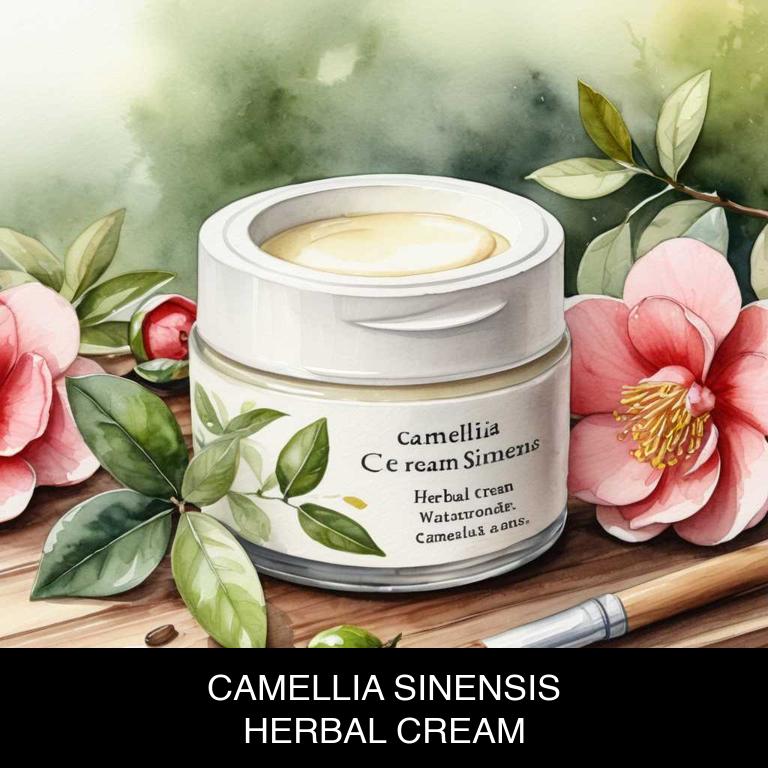
Medicinal Constituents
The list below shows the primary medicinal constituents in Camellia sinensis creams that help with frozen shoulder.
- Flavonoids: Flavonoids, such as quercetin and kaempferol, may help with frozen shoulder by reducing inflammation and oxidative stress, which contribute to the condition's progression.
- Polyphenols: Polyphenols, including epicatechin and epigallocatechin gallate, may aid in reducing inflammation and promoting tissue repair, which can help alleviate frozen shoulder symptoms.
- Catechins: Catechins, such as epigallocatechin gallate, may help with frozen shoulder by reducing oxidative stress, inflammation, and promoting tissue repair, ultimately leading to improved range of motion and reduced pain.
Parts Used
The list below shows the primary parts of tea used to make creams for frozen shoulder.
- Leaves: Leaves are used to make creams for frozen shoulder due to their anti-inflammatory and antioxidant properties.
- Stems: Stems are used to make creams for frozen shoulder as they are rich in flavonoids and phenolic acids, which have anti-inflammatory and analgesic effects.
- Buds: Buds are used to make creams for frozen shoulder due to their high content of flavonoids and phenolic acids, which help reduce inflammation and promote healing.
Quick Recipe
The following recipe gives a procedure to make a basic tea for frozen shoulder.
- Weigh 250 grams of dried camellia sinensis and grind it into a fine powder using a spice grinder.
- Steep the ground camellia sinensis in 500 milliliters of boiling water for 5 to 7 minutes.
- Strain the camellia sinensis infusion through a cheesecloth into a clean container and discard the solids.
- Mix 100 grams of beeswax and 200 grams of coconut oil in a double boiler over low heat.
- Combine the cooled camellia sinensis infusion with the melted beeswax and coconut oil mixture and stir well.
2. Capsicum annuum
Capsicum annuum, also known as bell pepper, creams helps with frozen shoulder because of its anti-inflammatory properties.
It contains capsaicin, a compound that blocks pain receptors, reducing discomfort and pain associated with frozen shoulder. The cream's warming effect also increases blood flow to the affected area, promoting healing and reducing stiffness.
Additionally, capsaicin's anti-inflammatory properties may help reduce swelling and promote joint mobility, making it a natural and effective treatment option for individuals suffering from frozen shoulder.
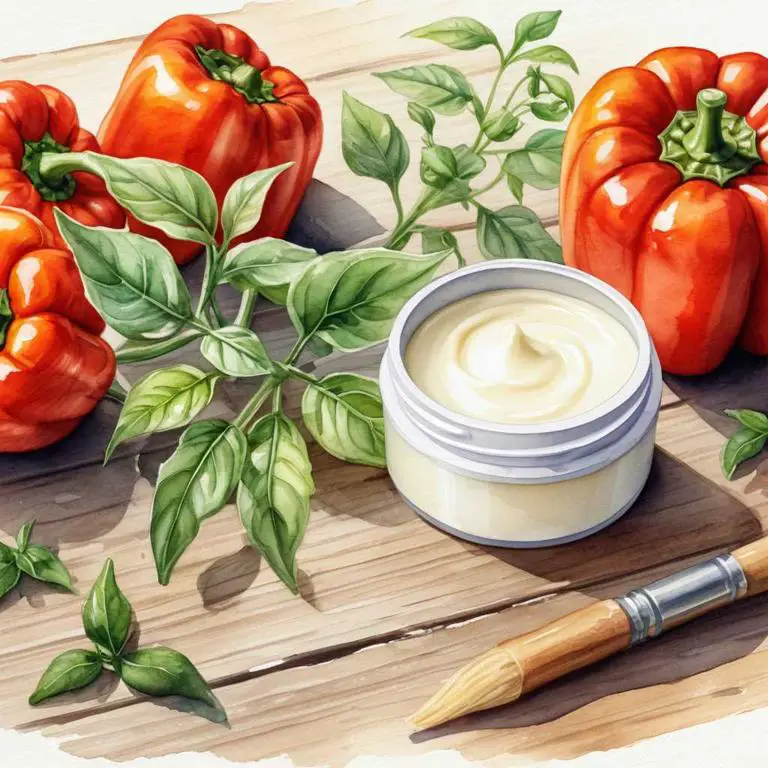
Medicinal Constituents
The list below shows the primary medicinal constituents in Capsicum annuum creams that help with frozen shoulder.
- Capsaicin: Capsaicin, a capsaicinoid found in Capsicum annuum, has analgesic and anti-inflammatory properties, which may help alleviate pain and reduce inflammation associated with frozen shoulder.
- Quercetin: Quercetin, a flavonoid phenolic compound, has anti-inflammatory properties that may help reduce inflammation and pain in the affected shoulder joint.
- Catecholamines: These catecholamines, which are a type of alkaloid, may help modulate the nervous system's response to pain, potentially leading to pain relief and improved range of motion in individuals with frozen shoulder.
Parts Used
The list below shows the primary parts of bell pepper used to make creams for frozen shoulder.
- Fruits: They are commonly used due to their high capsaicin content, which has anti-inflammatory properties that can help alleviate pain and stiffness associated with frozen shoulder.
- Leaves: The leaves may also be used, but their usage is less documented, possibly due to their lower capsaicin content compared to the fruits.
- Seeds: The seeds may be used as well, possibly for their similar properties to the fruits and leaves, but more research is needed to confirm their effectiveness.
Quick Recipe
The following recipe gives a procedure to make a basic bell pepper for frozen shoulder.
- Harvest fresh capsicum annuum fruits when they are fully ripe and their color has changed to a deep red.
- Dry the harvested fruits in a warm well-ventilated area for about 1 week or until they become brittle.
- Grind the dried capsicum annuum fruits into a fine powder using a coffee grinder or spice grinder for about 5 minutes.
- Mix 20 grams of the ground capsicum annuum powder with 50 grams of coconut oil in a double boiler over low heat for 30 minutes.
- Strain the mixture through a cheesecloth and discard the solids to obtain a smooth creamy herbal cream.
3. Glycyrrhiza glabra
Glycyrrhiza glabra, also known as licorice, creams helps with frozen shoulder because of its anti-inflammatory properties.
The active compound glycyrrhizin in Glycyrrhiza glabra root reduces inflammation and pain in the affected area. The cream's soothing and cooling effects also help to relax the muscles and improve range of motion. Additionally, Glycyrrhiza glabra's antioxidant properties promote healing and reduce oxidative stress, leading to faster recovery from frozen shoulder.
Its natural composition makes it an attractive alternative to conventional treatments.

Medicinal Constituents
The list below shows the primary medicinal constituents in Glycyrrhiza glabra creams that help with frozen shoulder.
- Glycyrrhizin: This triterpenoid saponin helps with frozen shoulder by reducing inflammation and pain due to its potent anti-inflammatory properties, which contribute to improved shoulder mobility.
- Licoricidin: This flavonoid glycoside exhibits anti-inflammatory and antioxidant properties, which help alleviate pain and inflammation associated with frozen shoulder, promoting relaxation and reduced stiffness.
- 18β-glycyrrhetinic acid: This triterpenoid saponin has potent anti-inflammatory properties, which contribute to improved shoulder mobility by reducing inflammation and pain, allowing for increased range of motion and reduced discomfort.
Parts Used
The list below shows the primary parts of licorice used to make creams for frozen shoulder.
- Roots: They are used due to their high content of glycyrrhizin, which has anti-inflammatory properties that can help reduce pain and swelling associated with frozen shoulder.
- Leaves: They are used because they contain various bioactive compounds that can aid in reducing inflammation and promoting healing in frozen shoulder.
- Barks: They are used due to their richness in glycosides and phenolic compounds, which have anti-inflammatory and antioxidant properties that can help alleviate frozen shoulder symptoms.
Quick Recipe
The following recipe gives a procedure to make a basic licorice for frozen shoulder.
- Extract 20-30 grams of dried glycyrrhiza glabra roots in 500 milliliters of boiling water for 15 minutes.
- Filter the liquid mixture through a cheesecloth into a clean container to remove the solids.
- Mix 10-15 grams of beeswax and 50 grams of shea butter with 100 milliliters of the herbal extract in a double boiler.
- Heat the mixture in the double boiler for 10-15 minutes or until the beeswax and shea butter are fully incorporated.
- Allow the mixture to cool and thicken before transferring it to a clean container for storage.
4. Salix alba
Salix alba, also known as white willow, creams helps with frozen shoulder because of its anti-inflammatory properties.
The cream's active ingredient, salicin, mimics the effects of aspirin, reducing pain and inflammation in the affected joint. By decreasing inflammation, the cream allows for improved range of motion and reduced stiffness. This helps to alleviate the pain and discomfort associated with frozen shoulder, allowing for a more comfortable and manageable condition.
Regular use may also aid in the healing process.
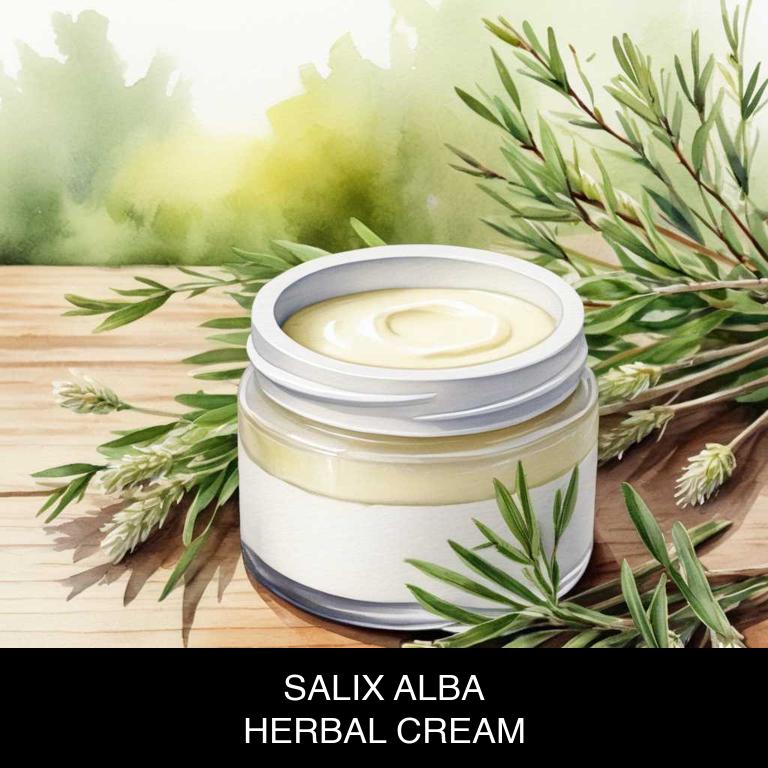
Medicinal Constituents
The list below shows the primary medicinal constituents in Salix alba creams that help with frozen shoulder.
- Salicin: A glycoside compound that acts as a natural anti-inflammatory and pain reliever, helping to reduce inflammation and alleviate pain associated with frozen shoulder.
- Salicortin: A flavonoid with anti-inflammatory and antioxidant properties, which may help to reduce oxidative stress and promote healing in the affected shoulder joint.
- Triterpenoids: A group of compounds with anti-inflammatory and immunomodulatory effects, which may help to reduce inflammation, modulate the immune response, and promote tissue repair in the affected area.
Parts Used
The list below shows the primary parts of white willow used to make creams for frozen shoulder.
- Barks: Used due to its anti-inflammatory properties, which help reduce pain and swelling associated with frozen shoulder.
- Leaves: Used because they contain salicylic acid, a compound that helps reduce inflammation and pain.
- Stems: Used due to its anti-inflammatory and analgesic properties, which help alleviate pain and stiffness in frozen shoulder.
Quick Recipe
The following recipe gives a procedure to make a basic white willow for frozen shoulder.
- Harvest 30g of salix alba bark, clean it thoroughly and dry it in a low-temperature oven for 2 hours.
- Grind the dried bark into a fine powder using a spice grinder or mortar and pestle.
- Mix the powdered bark with 20g of beeswax and 10g of sweet almond oil in a double boiler.
- Heat the mixture over low heat for 15 minutes, stirring occasionally, until the beeswax melts completely.
- Strain the cooled mixture through a cheesecloth into a clean glass jar and store in a cool dark place.
5. Echinacea purpurea
Echinacea purpurea, also known as purple coneflower, creams helps with frozen shoulder because of its anti-inflammatory properties.
The active compounds in Echinacea, such as alkylamides and polyphenols, work to reduce swelling and pain associated with frozen shoulder. Additionally, the cream's antioxidant properties help to promote healing and tissue repair.
By reducing inflammation and promoting healing, Echinacea purpurea creams can help to improve range of motion and alleviate the discomfort associated with frozen shoulder, making it a popular natural remedy for this condition.

Medicinal Constituents
The list below shows the primary medicinal constituents in Echinacea purpurea creams that help with frozen shoulder.
- Iridoid glycosides: These compounds may help reduce inflammation and pain associated with frozen shoulder by inhibiting the production of pro-inflammatory cytokines and enzymes.
- Phenolic acids: These antioxidant compounds can help reduce oxidative stress and inflammation in the affected shoulder joint, promoting healing and reducing pain.
- Alkylamides: These compounds may help reduce pain and inflammation by inhibiting the production of pain-causing chemicals, such as bradykinin, and promoting relaxation and reduced muscle tension.
Parts Used
The list below shows the primary parts of purple coneflower used to make creams for frozen shoulder.
- Roots: They are rich in inulin, which has anti-inflammatory properties beneficial for treating frozen shoulder.
- Flowers: They contain alkylamides, which have analgesic and anti-inflammatory effects, helping to alleviate frozen shoulder pain.
- Leaves: They are a source of caffeic acid and chicoric acid, which have anti-inflammatory properties that can aid in reducing frozen shoulder discomfort.
Quick Recipe
The following recipe gives a procedure to make a basic purple coneflower for frozen shoulder.
- Harvest 1 cup of dried echinacea purpurea flowers and roots from a trusted source.
- Steep the dried echinacea mixture in 2 cups of boiling water for 10 to 15 minutes.
- Strain the echinacea mixture through a cheesecloth or a fine-mesh sieve into a clean bowl.
- Combine 1/4 cup of beeswax and 1/4 cup of coconut oil in a double boiler.
- Blend 1/2 cup of the cooled echinacea liquid into the melted beeswax and coconut oil mixture.
6. Arnica montana
Arnica montana, also known as mountain arnica, creams helps with frozen shoulder because of its anti-inflammatory properties.
The active compounds in Arnica, such as sesquiterpene lactones, reduce swelling and ease pain by inhibiting the production of inflammatory mediators. This leads to improved joint mobility, reduced stiffness, and increased range of motion in the affected shoulder. By alleviating inflammation and promoting healing, Arnica creams provide relief from the pain and discomfort associated with frozen shoulder.
Regular application may also enhance recovery.
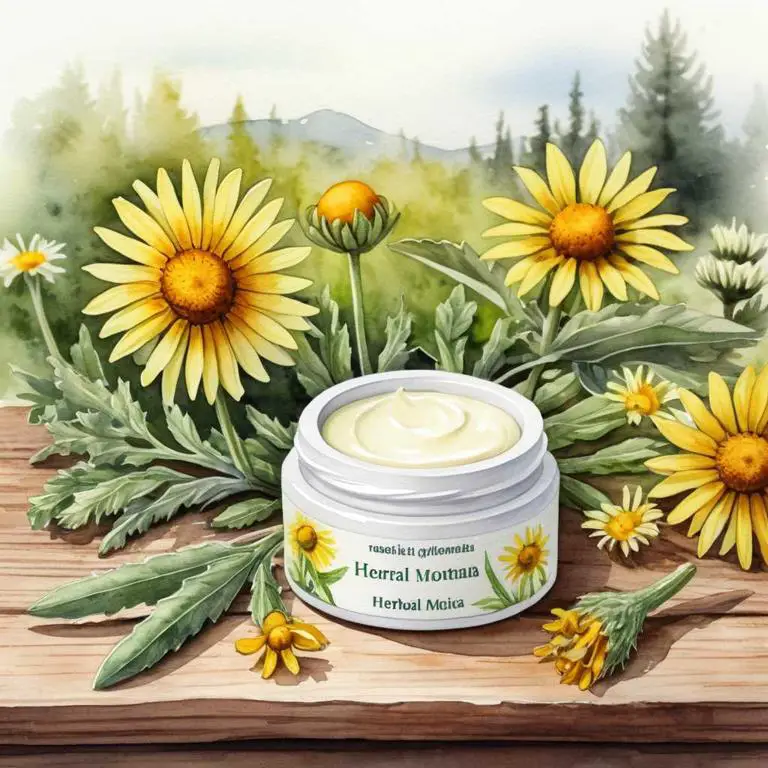
Medicinal Constituents
The list below shows the primary medicinal constituents in Arnica montana creams that help with frozen shoulder.
- Thymol: Thymol, a phenolic constituent, helps reduce inflammation and pain in frozen shoulder by its analgesic and anti-inflammatory properties.
- Bornanol: Bornanol, a terpene, helps relieve pain and stiffness associated with frozen shoulder by reducing inflammation and promoting relaxation of muscles.
- Caffeic acid: Caffeic Acid, a phenolic compound, helps reduce inflammation and pain in frozen shoulder by its potent anti-inflammatory and antioxidant properties.
Parts Used
The list below shows the primary parts of mountain arnica used to make creams for frozen shoulder.
- Flowers: Used due to their high concentration of sesquiterpene lactones, which have anti-inflammatory and analgesic properties.
- Leaves: Utilized for their ability to soothe and calm the affected area, reducing pain and inflammation associated with frozen shoulder.
- Roots: Employed for their medicinal properties, including anti-inflammatory and antioxidant effects, which can help alleviate frozen shoulder symptoms.
Quick Recipe
The following recipe gives a procedure to make a basic mountain arnica for frozen shoulder.
- Harvest 20-30 grams of dried arnica montana flowers and leaves from a trusted supplier or your own garden.
- Infuse the dried arnica montana in 200ml of carrier oil such as coconut oil at a ratio of 1:5.
- Steep the mixture in a warm place for 2-3 weeks or until the oil turns a light yellow color.
- Strain the oil through a cheesecloth into a clean glass container to remove the plant material.
- Mix the infused oil with beeswax and a small amount of vitamin e oil to create a smooth cream consistency.
7. Stevia rebaudiana
Stevia rebaudiana, also known as stevia, creams helps with frozen shoulder because of its anti-inflammatory properties.
The active compounds in Stevia rebaudiana, such as stevioside and rebaudioside, reduce inflammation and promote healing in the affected joint. The cream also helps to relax the muscles surrounding the shoulder, improving mobility and range of motion.
Additionally, Stevia rebaudiana's antioxidant properties help to protect the joint from further damage, promoting a faster recovery and reducing pain associated with frozen shoulder.
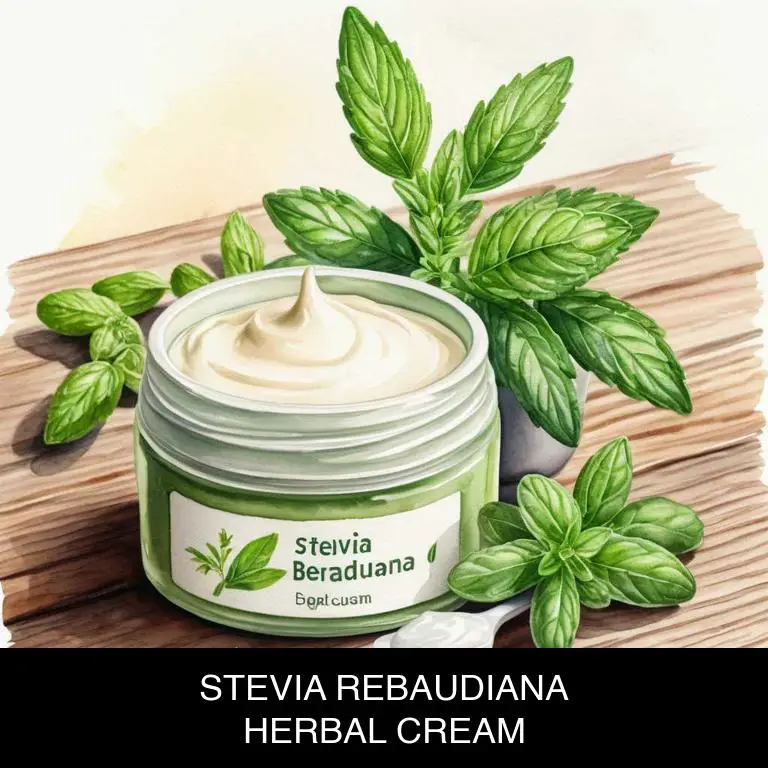
Medicinal Constituents
The list below shows the primary medicinal constituents in Stevia rebaudiana creams that help with frozen shoulder.
- Steviol glycosides: These compounds have anti-inflammatory properties, which may help reduce pain and swelling associated with frozen shoulder.
- Saponins: Saponins have been shown to have analgesic and anti-inflammatory effects, which may help alleviate pain and stiffness in frozen shoulder.
- Flavonoids: Flavonoids, particularly kaempferol and quercetin, have antioxidant and anti-inflammatory properties, which may help reduce inflammation and promote healing in frozen shoulder.
Parts Used
The list below shows the primary parts of stevia used to make creams for frozen shoulder.
- Leaves: Used to make creams for frozen shoulder due to their anti-inflammatory properties which can help reduce pain and inflammation.
- Roots: Utilized in creams for frozen shoulder because of their potential to reduce oxidative stress and promote tissue repair.
- Stems: Employed in creams for frozen shoulder due to their antioxidant properties which can aid in reducing inflammation and promoting healing.
Quick Recipe
The following recipe gives a procedure to make a basic stevia for frozen shoulder.
- Harvest 30-40 grams of stevia rebaudiana leaves and flowers from a mature plant in the morning.
- Infuse the harvested stevia leaves and flowers in 1000 milliliters of boiling water for 10-15 minutes.
- Strain the infused stevia liquid through a cheesecloth or a fine-mesh sieve into a clean container.
- Mix 20 grams of beeswax and 100 grams of shea butter with the cooled stevia infusion in a double boiler.
- Whip the mixture until it thickens and becomes a smooth, creamy texture, approximately 10-15 minutes.
8. Curcuma longa
Curcuma longa, also known as turmeric, creams helps with frozen shoulder because of its potent anti-inflammatory and antioxidant properties.
The active compound curcumin, present in these creams, works by reducing inflammation and modulating the immune response, which is often impaired in frozen shoulder cases. Additionally, curcumin's analgesic and anti-pain properties help alleviate the discomfort and stiffness associated with frozen shoulder, allowing for improved range of motion and reduced pain levels.
This natural remedy promotes healing and relaxation, making it an attractive alternative for those seeking relief from frozen shoulder.

Medicinal Constituents
The list below shows the primary medicinal constituents in Curcuma longa creams that help with frozen shoulder.
- Curcuminoids: These polyphenolic compounds, particularly curcumin, have potent anti-inflammatory and antioxidant properties, which help reduce inflammation and promote healing in frozen shoulder.
- Tumerones: These sesquiterpenoids have been shown to inhibit pro-inflammatory enzymes, reduce inflammation, and improve joint mobility, making them beneficial for frozen shoulder treatment.
- Demethoxycurcumin: This curcuminoid has potent anti-inflammatory and antioxidant properties, which may help reduce pain and inflammation associated with frozen shoulder, promoting faster recovery.
Parts Used
The list below shows the primary parts of turmeric used to make creams for frozen shoulder.
- Rhyzomes: They are widely used due to their high concentration of curcumin, a compound with anti-inflammatory and pain-relieving properties.
- Leaves: Leaves of Curcuma longa are used as they contain essential oils and other compounds that help reduce inflammation and promote healing.
- Roots: The roots of Curcuma longa are also used as they are rich in curcumin and other bioactive compounds that aid in reducing pain and inflammation.
Quick Recipe
The following recipe gives a procedure to make a basic turmeric for frozen shoulder.
- Grind 10 grams of dried curcuma longa roots into a fine powder using a spice grinder.
- Combine 2 tablespoons of the ground curcuma longa powder with 1 tablespoon of beeswax in a saucepan.
- Heat the mixture over low heat for 10-15 minutes or until the beeswax is fully dissolved.
- Stir in 2 tablespoons of coconut oil and 2 tablespoons of shea butter to the saucepan mixture.
- Pour the mixture into a bowl and let it cool to room temperature for 30 minutes before whipping.
9. Symphytum officinale
Symphytum officinale, also known as comfrey, creams helps with frozen shoulder because of its anti-inflammatory properties and ability to promote tissue repair.
The cream's active compounds, such as allantoin and rosmarinic acid, reduce swelling and pain associated with frozen shoulder. Additionally, comfrey's mucilages soothe and protect the affected joint, allowing for improved mobility and flexibility.
This natural remedy can provide relief from frozen shoulder symptoms, making it a popular alternative treatment for those seeking a more holistic approach to pain management.
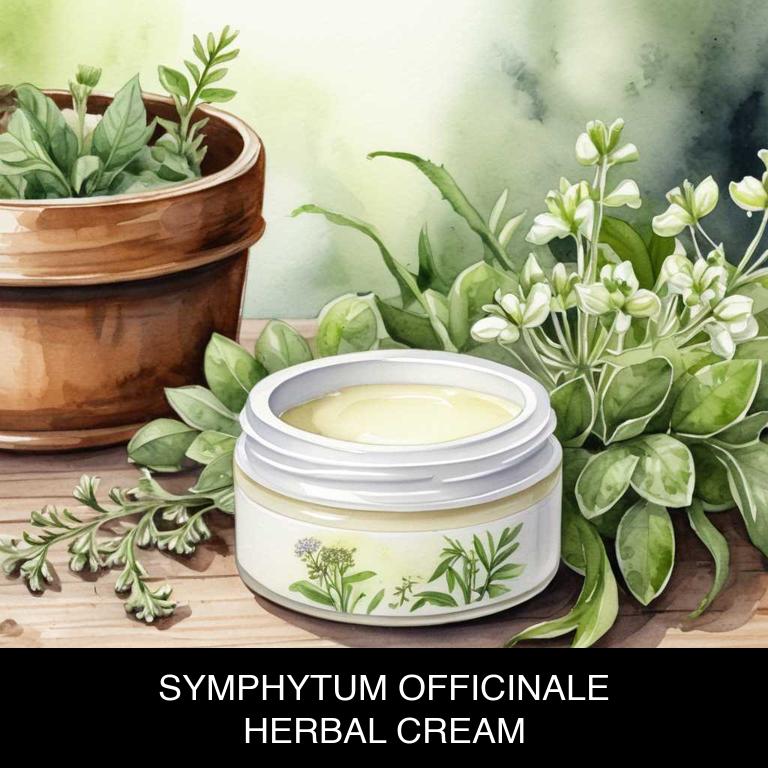
Medicinal Constituents
The list below shows the primary medicinal constituents in Symphytum officinale creams that help with frozen shoulder.
- Aesculin: Aesculin, a phenolic glycoside, helps with frozen shoulder by reducing inflammation and promoting blood flow to the affected area, which contributes to the recovery of range of motion.
- Tannins: Tannins, a type of polyphenol, aid in frozen shoulder treatment by reducing inflammation and pain, while also preventing the degradation of connective tissue, thereby facilitating the healing process.
- Allantoin: Allantoin, a urea derivative, assists in frozen shoulder recovery by promoting the breakdown and removal of scar tissue, which can contribute to the limited mobility characteristic of frozen shoulder.
Parts Used
The list below shows the primary parts of comfrey used to make creams for frozen shoulder.
- Leaves: The anti-inflammatory and mucilaginous properties of the leaves are used to soothe and reduce pain in frozen shoulder, making them a common ingredient in creams.
- Roots: The roots of Symphytum officinale contain alkaloids that provide anti-inflammatory and analgesic effects, which are beneficial for frozen shoulder relief.
- Stems: The stems of Symphytum officinale also contain mucilaginous properties, which help to reduce inflammation and promote relaxation in frozen shoulder sufferers.
Quick Recipe
The following recipe gives a procedure to make a basic comfrey for frozen shoulder.
- Harvest 50g of fresh symphytum officinale leaves and flowers on a sunny morning for optimal potency.
- Clean and dry the harvested plant material in a warm place for 24 hours to prevent contamination.
- Combine the dried plant material with 100g of carrier oil in a small saucepan and heat gently over low heat for 2 hours to infuse the oil.
- Strain the infused oil through a cheesecloth into a clean glass bowl and discard the solids after 30 minutes.
- Mix 50g of the infused oil with 50g of beeswax in a small saucepan and heat over low heat until the wax melts completely after 20 minutes.
10. Artemisia absinthium
Artemisia absinthium, also known as wormwood, creams helps with frozen shoulder because of its potent anti-inflammatory properties.
The active compounds in wormwood, such as thujone and flavonoids, work together to reduce inflammation and relax muscles, making it easier to move the affected joint.
Additionally, wormwood's analgesic properties help alleviate pain associated with frozen shoulder, allowing for improved range of motion and reduced discomfort, ultimately promoting faster recovery and relaxation in the affected area.
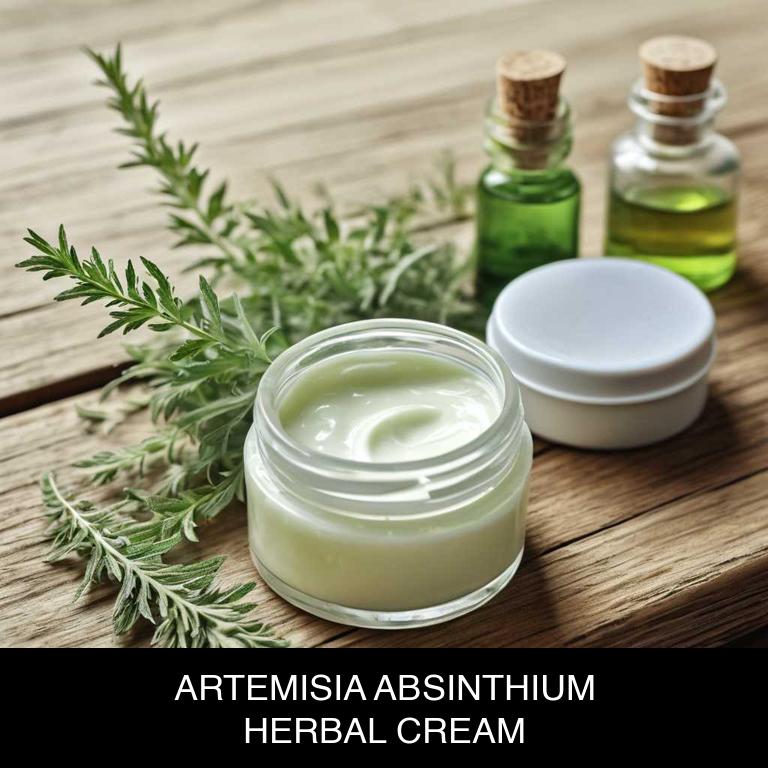
Medicinal Constituents
The list below shows the primary medicinal constituents in Artemisia absinthium creams that help with frozen shoulder.
- Thujone: Thujone has anti-inflammatory and analgesic properties, which can help reduce pain and inflammation associated with frozen shoulder, allowing for improved mobility and range of motion.
- Bornyl acetate: Bornyl acetate is a terpene that has been shown to have anti-inflammatory and antioxidant effects, which can help reduce swelling and promote healing in the affected shoulder joint, thereby alleviating frozen shoulder symptoms.
- Absinthin: Absinthin is a phenolic compound with anti-inflammatory and antispasmodic properties, which can help relax muscles, reduce pain, and improve joint mobility in individuals with frozen shoulder.
Parts Used
The list below shows the primary parts of wormwood used to make creams for frozen shoulder.
- Leaves: Artemisia absinthium leaves are used due to their anti-inflammatory and antispasmodic properties, which can help alleviate pain and stiffness associated with frozen shoulder.
- Stems: Artemisia absinthium stems are used for their antispasmodic and anti-inflammatory effects, which can help reduce muscle spasms and inflammation in the affected shoulder joint.
- Flowers: Artemisia absinthium flowers are used due to their anti-inflammatory and antispasmodic properties, which can help reduce pain and inflammation in the frozen shoulder, promoting relaxation and healing.
Quick Recipe
The following recipe gives a procedure to make a basic wormwood for frozen shoulder.
- Harvest 1 part of dry artemisia absinthium leaves and flowers in the early morning when the dew is still present.
- Steep 1 part of the harvested plant material in 5 parts of carrier oil like sweet almond oil for 2 weeks.
- Strain the mixture through cheesecloth or a coffee filter into a clean container to separate the oil from plant material.
- Mix 5 grams of beeswax with 10 grams of the infused oil to create a smooth and stable cream base.
- Whip the mixture with a hand mixer or blender until it becomes light and fluffy like whipped cream.
What is the best combination of herbal creams to use for frozen shoulder?
The best combination of herbal creams that help with frozen shoulder is Turmeric and Ginger cream, combined with Arnica and Boswellia creams.
Turmeric's anti-inflammatory properties help reduce pain and swelling, while Ginger aids in improving blood circulation. Arnica cream accelerates the healing process by reducing inflammation and promoting collagen synthesis. Boswellia, also known as Frankincense, has anti-inflammatory and anti-arthritic properties, which help reduce pain and stiffness associated with frozen shoulder.
These creams can be used in combination or alternated for optimal results.
What ailments similar to frozen shoulder are treated with herbal creams?
Ailments similar to frozen shoulder that are treated with herbal creams are conditions characterized by inflammation, stiffness, and limited mobility.
These include arthralgia (joint pain), tendinitis (inflammation of tendons), and bursitis (inflammation of fluid-filled sacs).
Herbal creams containing anti-inflammatory agents like capsaicin, arnica, and ginger can help alleviate symptoms such as pain, swelling, and stiffness, promoting relaxation and reducing discomfort.